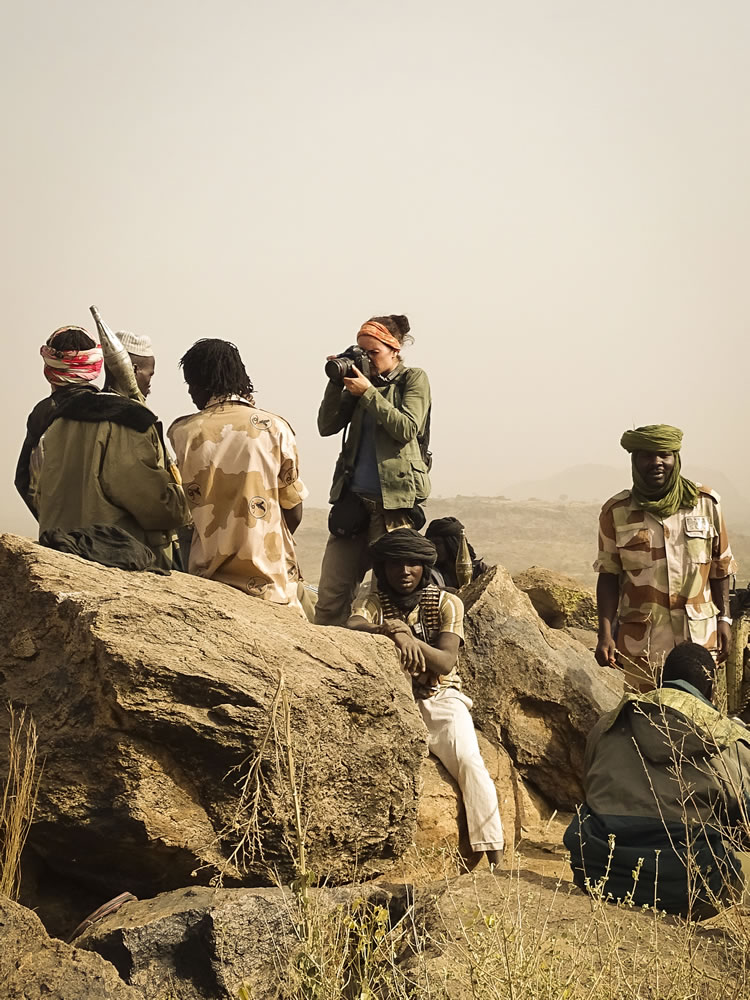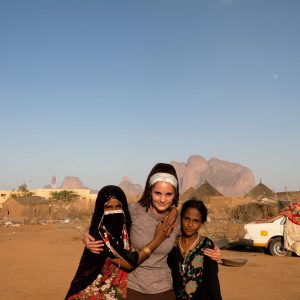Photos by Adriane Ohanesian ’08
The world was different in 2008. Not simpler. Different.
In January, stock markets around the world plunged amid fears of a U.S. recession. In November, the son of a Kenyan farmer, Barack Hussein Obama, was elected as the 44th president of the United States – the first African-American to do so.
In Darfur, a western region of the Northern African country of Sudan, a major civil war had been going on for five years. By 2008, the United Nations estimates that between 200,000-300,000 people had been killed in the conflict, and 2.7 million displaced from their homes. Half of those people were children, with 700,000 under the age of five having grown up knowing no life but that affected by the conflict.
Adriane Ohanesian ’08 arrived in the Sudan in August of 2010. This is her story.
A native of upstate New York, Ohanesian majored in anthropology at Colorado College. Her senior thesis, “Women, Ritual, and the Reproduction of Culture in Bali, Indonesia,” visually documented Balinese families during times of grief and ritual. Using this work as a portfolio, Ohanesian applied to the International Center of Photography in New York City. She graduated a year later, in 2010, with an advanced certificate in photojournalism and documentary photography.
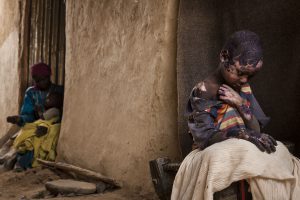
Adam Abdel, age 7, was badly burned when a Sudanese government’s Antonov plane dropped a bomb next to his family’s home on February 12, 2015 in Burgu, Central Darfur, Sudan. Photo taken February 27, 2015.
“I knew I wanted to do documentary photography, right from the start,” she says. “I’m lucky, I’ve been able to stick with that and make a career out of it.”
“Documentary photography is, for me, about creating documents,” Ohanesian explains. “I want the photos I take to be trusted and recognized as documents. I try not to manipulate the viewer with my work; I try to tell the truth – an undisturbed version of what I see when taking the picture.”
Finishing photography school, Ohanesian joined forces with a friend in applying for a National Geographic Young Explorers grant. They got the grant, and by August they were on the ground in Sudan, documenting the unfolding conflict.
“It all happened so quickly,” she recalls.
“I knew there was a referendum happening in the south of the country to decide on their independence. It was interesting and newsworthy, so I went.
“I had no idea what I was doing! I had no contacts beyond the friends of friends, and I arrived with the wrong permit. I stayed for nearly three years.”
Ohanesian began as a freelancer by knocking on the doors of major non-governmental organizations, even the UN, to find some interest in her work. Constantly taking photos, it “took awhile before anyone really recognized what I was doing,” she remembers.
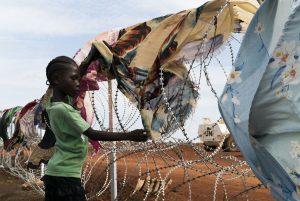
Farida, 7, takes down dried clothes hanging on the outer fence of the United Nations Protection of Civilians Site that currently houses over 30,000 displaced people in Wau, South Sudan. July 29, 2016.
As a freelancer who has worked with Reuters, Getty, The Wall Street Journal, the New Yorker, National Geographic, TIME, VICE News, and Al Jazeera to name a few, Ohanesian’s livelihood depends on her craft, which in turn depends on her location. Photography is, by its nature, a situational form of journalism. You have to be in the right place,
at the right time, to tell the right story.
“It’s extremely frustrating work,” Ohanesian admits. “At the same time, though, it’s kept me sane to a certain extent because I’m constantly learning my place as a photographer.
“Very quickly, you learn to understand that your role is to document situations in the most honest way possible, and then to distribute that information to audiences.”
There are limitations to journalism, though, and not every picture brings a policy change.
“Would it be ideal if my photos sparked a greater reaction, a debate about policy, or even a policy change? Yeah, that’s the ideal – but that’s a rare bonus. The main role I have is to get the information, to have a record of what has happened.”
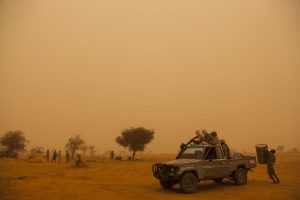
Rebel soldiers from the Sudan Liberation Army leave their camp to find water in the middle of a sand storm in North Darfur, Sudan. Feb. 24, 2015.
One of Ohanesian’s most recent stories, for VICE News, speaks to this greater reaction, this impact, that the work of journalism can have. A Somali refugee, a boy named Mohamed, has until very recently been living in Nairobi. Separated from his mother who now lives in the U.S., Mohamed has been in the horrific limbo that hundreds of thousands of refugees around the world find themselves in – torn from their homes, their families, but with seemingly no place to go. In collaboration with journalists Nick Miriello and Julia Steers, Ohanesian’s story provoked a stunning response.
“Once the United Nations High Commissioner for Refugees (UNHCR) gives Mohamed his refugee status in Kenya,” Ohanesian explains, “a human rights organization has offered to step in, buy him supplies, and pay for his plane ticket to reunite with his mother in the U.S.”
The outcome hangs in the balance, but the signs of hope, of that greater reaction toward positive change, are there.
That role has limitations, both personal and professional, and Ohanesian doesn’t shy away from that. “In many cases, I know I’ve disappointed people,” she explains.
“A lot of my work is done in incredibly rural locations. In Darfur, they’d not seen any foreigners for years. So, when I show up on location, people are hoping I’m a doctor, bringing supplies. I know that’s been a letdown for people, my not being able to help with their more immediate problems of sickness, sexual violence, and so on.”
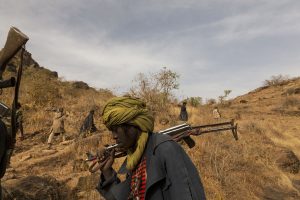
The Sudan Liberation Army led by Abdul Wahid (SLA-AW) climbs toward the front lines in the last rebel-held territory in Central Darfur, Sudan. March 4, 2015.
In the sensitive situations that Ohanesian often finds herself in, “clarity,” she says, “is the key to everything.”
“I make sure to explain to people what I’m doing, about the limitations of my work and my role. I don’t want to give people false hope, so discussions are really important – I try to be really honest about what I do. You have to be very clear about your work, your intentions, and most importantly, your limitations.”
Those limitations, of agency and ability, can be brought into sharp relief at any moment. Working in active conflict zones such as Darfur, Myanmar, Burundi, and Somalia, Ohanesian is often reminded of her foreignness – sometimes a blessing, other times a burden.
“In certain situations, my being an international journalist works to my advantage. In South Sudan, I’ve been able to cover both the government and rebel sides because it’s an ethnic war – nobody questions if I take sides with one group or another.”
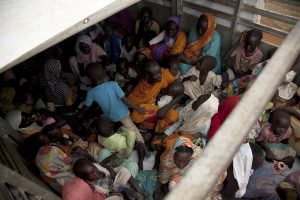
Women and children pile into the back of a truck that will take them from Jamam refugee camp to Yusuf Batil refugee camp in Upper Nile, South Sudan. July 2, 2012.
As regularly as her status as a white, foreign journalist opens doors, it could as easily bring about captivity, she says.
“Where it’s not to my advantage is somewhere like Somalia,” she says. “An American in Somalia is
a prime target. Not to brag, but I’d be worth quite a lot of money to a terrorist group like Al-Shabaab!”
With dangers such as being held hostage a very real possibility, and seeing the conflicts and horrors that she has, it would surprise nobody if Ohanesian were hardened and jaded to the world around her.
That, happily, couldn’t be further from the truth.
“Of course, you help when you can and where you can,” she says.
“The first thing, before you even think about helping, is understanding your role. People have asked me before, ‘Are you a human first, or a photographer first?’ I get frustrated with that question, because it’s so much more complicated than that! Everything is circumstantial, especially in more dangerous areas. You have to be aware of who’s around you, what their affiliations are. It’s not as easy as just marching into a place and thinking you can make a decision for people or that you know better than the people who’re living that experience.”
“If it’s safe for you, and the people around you, then of course you help. The thing is, a lot of the time it’s not safe, and you have to take that into consideration. Good intentions can easily be skewed or seen the wrong way. It’s vital that you understand the situation and the repercussions of the help you give.”
“For instance,” she continues, “a lot of the settings I find myself in are incredibly fragile. If you’re caught in the capital, in South Sudan, with someone of a certain tribe you can get that person killed. As an international they might not go after me, but they will absolutely go after the South Sudanese person in my car – the person I was simply giving a ride to.”
With the clarity of focus that shows so clearly in her photography, she advises, “You have to be really, really careful, and try not to leave a place worse than you found it.”
What keeps someone going, though, amid such constant instability, risk, and struggle? How do you keep your head, your eye?
For Ohanesian, showing her roots as a scholar of anthropology, that hope lies in people.
“The people that I meet are always hopeful,” she says.
“I think we forget here, particularly in the U.S., just how much power we have. There are so many people in the world who don’t have any of these things, have so little access or agency, and yet they still have an unbelievable amount of hope.”
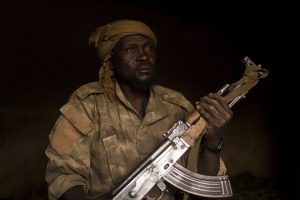
Ali Osman, who was originally part of Sudan’s government forces and now fights with the SLA-AW rebel group as a sniper, sits for a portrait in Central Darfur, Sudan. March 3, 2015.
There’s a caveat to this hope, though, for Ohanesian – and it’s a big one.
“People can adapt to almost anything, it’s amazing how strong and resilient people can be – but that doesn’t mean it’s an acceptable way of life, it doesn’t mean they should have to adapt to those things.”
“So much of international aid and relief work is simply putting Band-Aids over the deeper wounds,” she says. “There’s definitely a role for emergency aid, medical care, but they’re not simple situations and they don’t have simple solutions. What’s more important for the people in those situations is that they need a government that’s going to look after them, they need peace in their country. We forget that people can take care of themselves; they just need to be in a space that will allow them to do that.”
Stability and clear policy, then, are the far larger, more vital, issues in Ohanesian’s eyes. Not solely in Darfur, either, but in the conflict zones and failed states around the world where she does her work.
This is where the work of Ohanesian, as well as that of her fellow journalists and photographers, comes into play – where that “rare bonus” of her role begins to enter the equation.
“The ultimate goal would be to present images, a record, and to have that influence policy in the future or maybe serve as evidence in a court or to change international policy on Sudan,” she says. “There’s a need to record things that happen, even if you don’t see a direct effect because of doing that.”
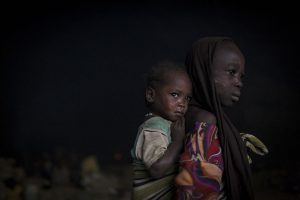
In the early morning, sisters wake in a cave where they sleep with others whose villages have been destroyed and are now living in the mountains outside of Sarong, Central Darfur, Sudan. March 2, 2015.
“There are times when life surprises you, and you do your work and you think nothing will come of it and something happens – like the work from Darfur, for example. All of a sudden, I find that I can talk to the International Criminal Court or the UN Security Council and they’re paying attention, looking at what’s been documented, and reopening cases against warlords.”
“People do notice, the work does have an effect, but if you don’t do that work then there’ll never be an opportunity for that work to have an effect. If people take that photographic record I create, and use it to create positive change in these situations, then that’s for the best.”
Ohanesian has received numerous awards for her work, including the Anja Niedringhaus Courage in Photojournalism Award, a 2016 World Press Photo award for her work in Darfur, and an award from National Geographic in 2014. She has also been recognized as one of Magnum Photo’s top “30 under 30” and received LensCulture’s Emerging Talent Award for her photographs of women soldiers in rebel-controlled Kachin, Myanmar. In 2015, Ohanesian was selected as one of Getty Images Emerging Photographers. Her photographs have been published by: Al Jazeera, The Wall Street Journal, National Geographic, and TIME. She lives in Nairobi, Kenya.
